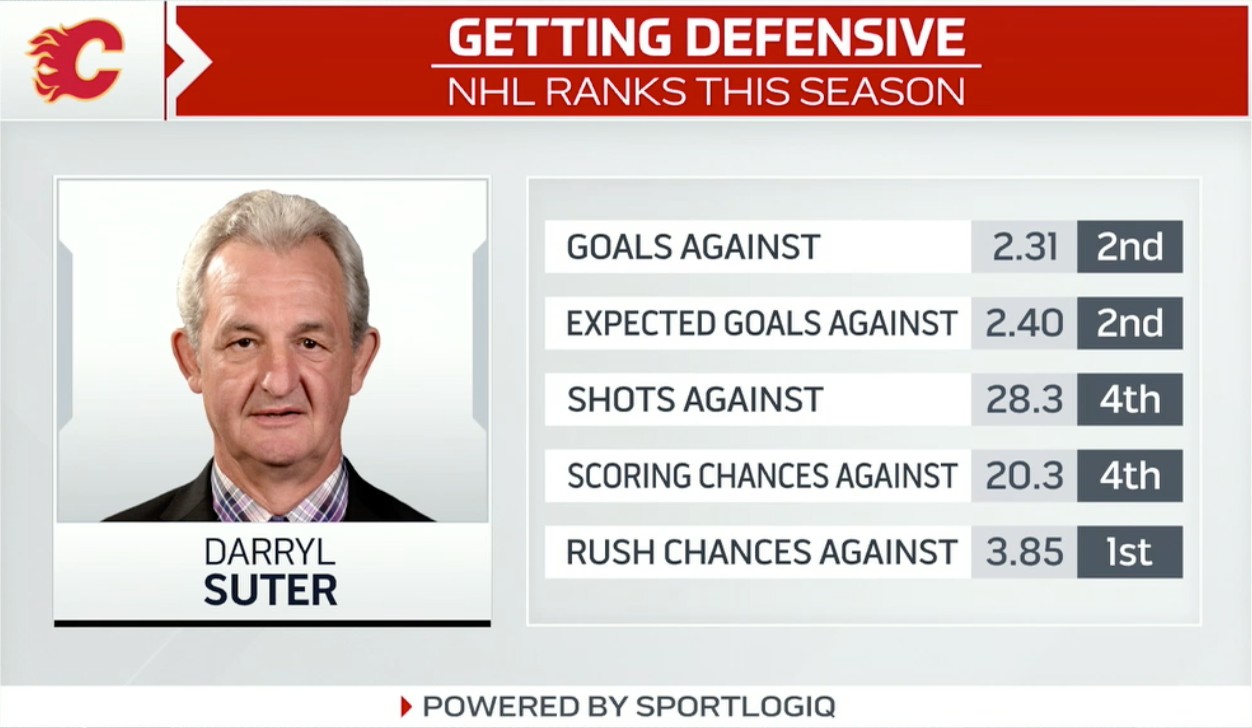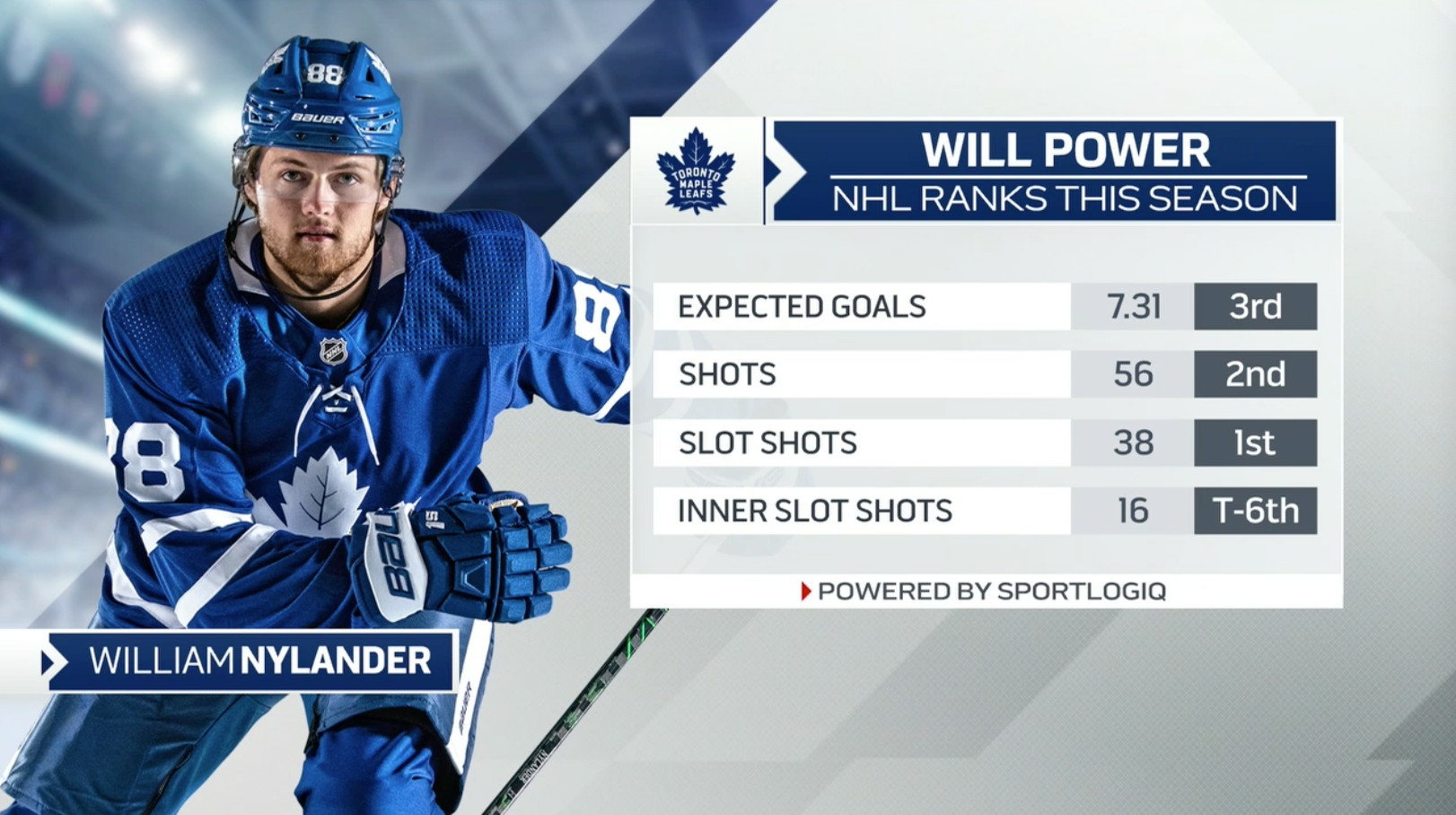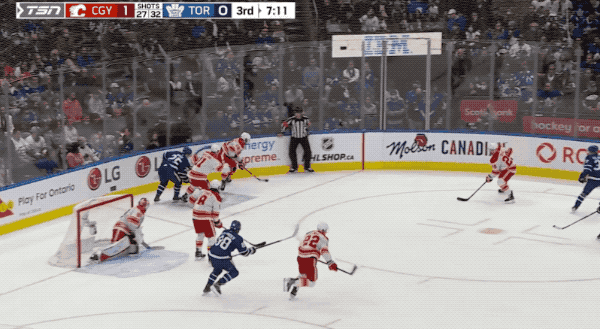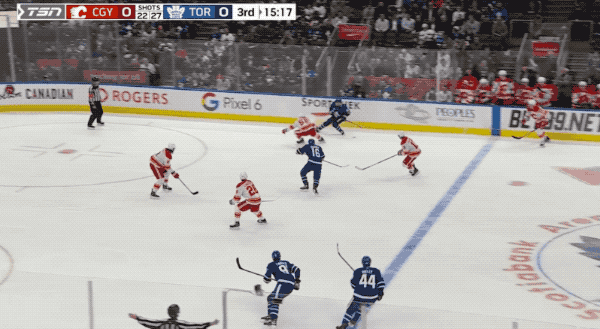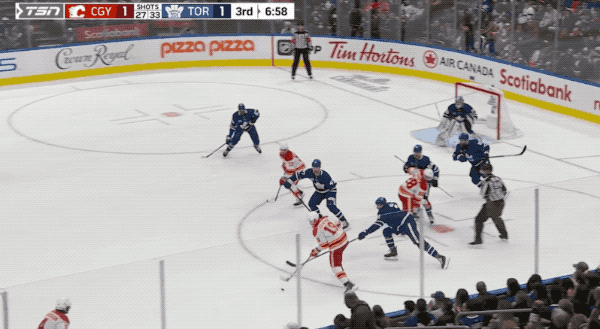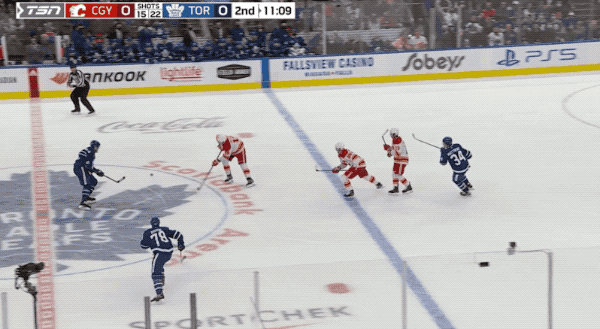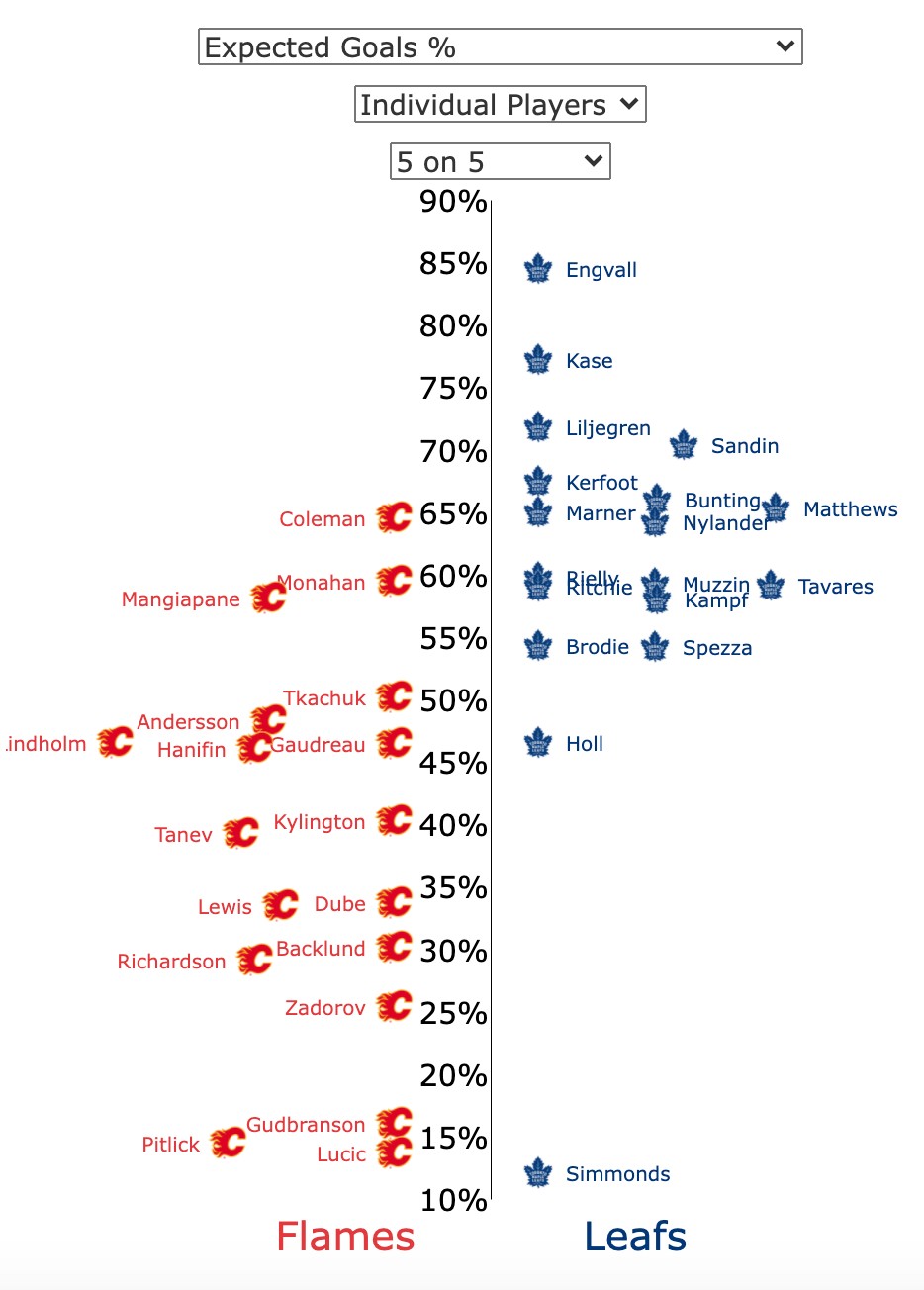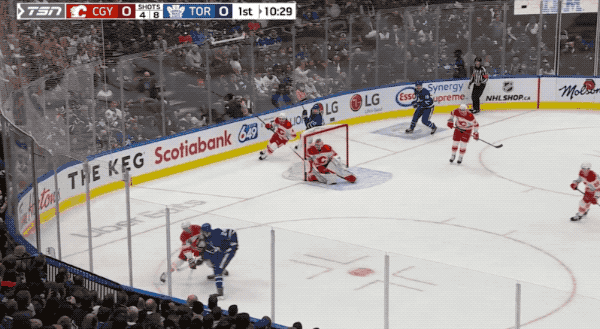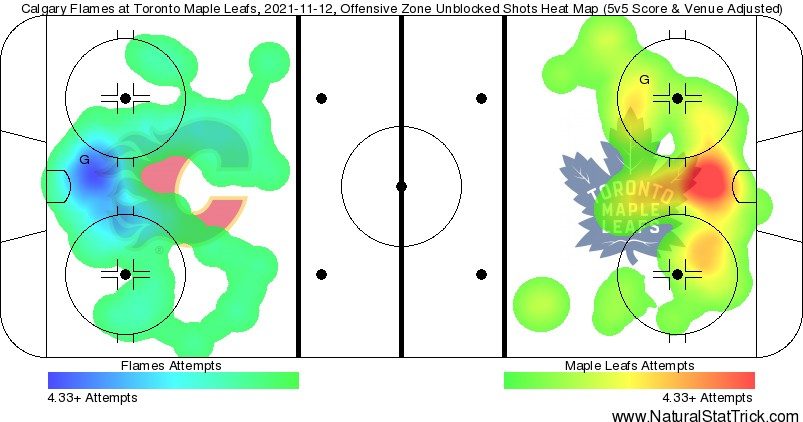That was not Darryl Sutter hockey.
When you heard the Leafs were going up against this team, the last thing you’d expect was a fun hockey game with a lot of quality scoring chances.
Defensive systems be damned, Toronto found a way to blow by Calgary’s aggressive forecheck and generate lots of open space for their talented forwards offensively. In particular, William Nylander and Mitch Marner did a phenomenal job of breaking Calgary’s structure with their speed and creativity, while Auston Matthews managed to get off nine chances from the slot on a night where he appeared to be fighting the puck all game.
When their stars are rolling, this Leafs team is a hard team to beat. It’s the way they’re constructed; Toronto is a top-heavy team that relies on strong performances from their best players to win games. That’s clearly been the case as of late, which makes for some entertaining hockey to break down.
Depth scoring is an issue we’ll touch on later, but for now, let’s start by analyzing the best performers on Friday night. It’s time for some Leafs Report Cards!
5 Stars
William Nylander (RW, #88) — Now’s a great time to remind ourselves of the terrible Nylander trades everyone has been talking about for years. “You can’t keep adding skill, you need to trade this first-line winger for a second pairing defenseman.”
Or you could simply play the talented hockey player more and watch him thrive in a bigger role.
The numbers don’t lie. He’s been generating shots at an elite rate this season, second only to Alex Ovechkin. Tonight was no exception, with Nylander firing nine shots towards the net, seven of them from the slot. It was hard to believe he’d gone almost the entire game without lighting the lamp, until Alex Kerfoot found him for a one-timer late in the third period (technically, it’s a primary assist on a tip by Ondrej Kase).
This is why we care about expected goals. If you keep getting high-quality chances, eventually, the pucks are going to go in. This is a fact you can confirm by going through the last 10+ years of public hockey data.
Getting back to Nylander’s game, I’m willing to bet he’s Toronto’s fastest skater at this point. He’s absolutely blowing by quick NHL skaters in the neutral zone, leading to a bunch of odd-man rushes. He’s also not afraid to pull off high-skill moves on these rushes, toe-dragging his way around defenders to turn a 2-on-1 into a breakaway.
Somehow, none of his rush chances found the back of the net tonight, but if he keeps generating offense at the rate he has so far this season — and continues to get minutes in line with his talent for once — I have no doubt he’s going to set a career-high in goals and points this season.
Welcome to William Nylander’s breakout season. I hope you’re having as much fun watching it as I am. And to all the hockey dads out there who have had it in for this guy since Day 1, how’s that going for you right now?
The Marner-Kerfoot Duo — This isn’t a combination that I would’ve thought would work at 5v5, but it worked tonight. These two were making give-and-go passes to each other with ease in the offensive zone, maintaining possession on the cycle, and really spreading the ice horizontally with east-west passes.
Mitch Marner, in particular, was fantastic in this department, threading numerous passes from out wide to the front of the net. It’s hard to believe he finished this game without a point considering how dominant he was with the puck on his stick. This was one of those nights for Marner where he was making magical plays shift after shift, using his passing to get his teammates into wide-open ice.
He was also making a concerted effort to get below the goal line on PP again, which is going to be a key factor in this power play sustaining its success. None of his passes from there resulted in scoring chances, but it’s an under-utilized area on the ice that can lead to very efficient offense. I love that Toronto is putting him in a position to leverage his strengths as a behind-the-net playmaker.
For my money, this was one of Alex Kerfoot‘s best games as a Leaf. He’s not a Marner-level passer, but passing has always been his greatest asset. Well, that and his shiftiness as a skater to avoid defenders in the neutral zone. Kerfoot looked like a legitimate top-six forward in this game, completing passes to his talented linemates at a high rate, putting them in a good position to get shots off.
Now, I didn’t love Marner or Kerfoot’s coverage on the Oliver Kylington goal, even though their strong play from start to finish more than made up for it, at least in my opinion.
Everyone knows that Morgan Rielly likes to jump up in the play for offense, which is what makes covering for him as the F3 so crucial. Kerfoot is the high forward on this play and fails to recognize it (which happens far too often), while Marner skates at the wrong guy when he probably could have stayed with Kylington the whole way on the backcheck.
As a side note, how the heck did no one take a flier on Kylington when he was on waivers last year? He’s been one of the best defensemen in the AHL for a while, had a great draft pedigree, is an excellent puck-mover, and was still just 23-years-old when he got waived.
Oh shit, Boston could get Barzal, Connor, and Kylington here
— Rhys Jessop (@Rhys_Jessop) June 27, 2015
It’s a nice healthy reminder that sometimes NHL front offices make mistakes, too.
4 Stars
Jack Campbell (G, #36) — He battled hard towards the end in this game. I never love drawing any major conclusions from 3-on-3 overtime, but it’s hard not to appreciate Campbell sprawling from one side of his crease to the other when Calgary was zipping the puck around, only to get himself in perfect position for the Andrew Mangiapane shot at the end of it.
Campbell also came up clutch with a big save on a backdoor pass late in the third period.
He’s still rocking a .936 save percentage, which ranks first among goaltenders with at least 10 starts this season. Campbell also leads the league in goals saved above average, so I think it’s safe to say he’s off to a hot start.
TJ Brodie (LD, #78) — His partner had an adventure for a night in this game, but luckily for Morgan Rielly, old reliable was the last man back to save the day on most occasions.
Brodie looked like his 2020-21 self on Friday night, blocking passes through the middle of the ice with consistency. It’s his biggest strength as a defender, taking away the most efficient forms of offense, forcing opposing forwards to settle for outside shots off the rush.
Justin Holl (RD, #3) — I saw some people arguing that Holl had a rough night. Personally, I thought he did a great job of keeping the Leafs on the right side of the ice. He was making well-timed pinches down the right wall to keep his team on offense, even chipping in offensively with a nice point shot that almost fooled Daniel Vadar (which, by the way, sounds like a Bond villain).
Holl also made a nice stretch pass up to Spezza, who wasn’t able to blow by Erik Gudbranson of all people on the net drive.
Ondrej Kase (RW, #25) — Let’s take a moment and think about his usage. Kase doesn’t get any power play time and is forced to spend his 5v5 minutes alongside a center who can’t complete a pass to him (David Kampf) and the 6’5 enigma who can’t seem to put his shiny toolkit together (Pierre Engvall) — even though I think we might all be weirdly underrating Engvall at this point.
Kase was struggling to move the puck up the ice when Kampf was centering his line, but when the Leafs desperately needed some offense, Sheldon Keefe played him alongside some players who could actually make a play in transition. Here’s a look at the top six he threw out in the final 10 minutes of the game when Toronto was trailing:
Tavares-Matthews-Marner
Nylander-Spezza-Kase
They also tried:
Tavares-Matthews-Marner
Nylander-Kerfoot-Kase
Those lines looked explosive offensively, with Kase getting himself into shooting positions frequently, using his one-timer from distance to provide a bit more spacing in the offensive zone. He also blew by both Calgary defenders off of a DZ faceoff win, darting down the ice for a breakaway.
It’s been so hard watching Kase try to carry players who can’t keep up with him offensively, so here’s hoping this game helped show the coaching staff that he can thrive alongside more talented linemates who can get him the puck. Heck, he scored the game-tying goal by scoring exactly the type of goal that Keefe & Co. want to see more of in the playoffs — by going hard to the net with his stick on the ice.
On Kase getting credited with the tip of Nylander's goal, Keefe: "Good news for the coach because it's a lot of what we talked about throughout the game, which is get to the net, get some redirects and tips and stuff like that."
— David Alter (@dalter) November 13, 2021
Rewarding Kase with better linemates would be one way to reinforce such behaviour.
3 Stars
John Tavares (C, #91) — As Ray Ferraro put it on the broadcast, Tavares is playing as well as he has in years. I didn’t think this was his best game of the season, but we still saw flashes of what’s made him so effective this year. He was using his agile feet to work his way out of tight spaces, especially along the boards.
Tavares was also battling for the tough ice, winning 1-on-1 battles through sheer determination, which is a nice reminder that Toronto’s “Core Four” isn’t entirely skill-based. He wins a lot more pucks with his physicality than most people realize.
Jake Muzzin (LD, #8) — Going with another veteran here, Muzzin had a solid night. Nothing super noteworthy positively or negatively; he just did his job as the stabilizing presence on Toronto’s shutdown pair. His best moments were a shot block on Mangiapane in the slot and a few hard closeouts in the neutral zone.
The Sandin-Liljegren Pair — They didn’t dominate play as well as they have in recent games, but they still ended up on the positive side of the ledger. Timothy Liljegren continues to do a great job of playing a tight gap when defending the rush. He’s really good at getting his body in the way as the opposing forward tries to get around him, slowing them down and giving Toronto’s forwards time to catch up on the backcheck.
Offensively, my favourite Rasmus Sandin shifts were alongside Matthews-Nylander. Those three do such a great job zipping the puck around the offensive zone with smart movement off the puck to get themselves open for the next pass. I’d love to see Sandin get even more shifts with these two; it’s a great way to leverage his strengths as a passer.
Auston Matthews (C, #34) — This is such a strange one. If you watched Auston Matthews play on Friday night, he didn’t look like himself; he wasn’t able to break his man down in 1v1 situations; passes onto his tape were getting bobbled. It just felt like he was fighting the puck on most shifts.
Despite all that, he had a bunch of one-timer opportunities (I counted three), fired 13 shot attempts towards the net, nine of which came from the slot, and won the game in overtime with a gorgeous release off the rush.
I’m starting to think this guy just might be good at hockey.
Matthews isn't blowing up the point totals so far this season but he's been excellent. #LeafsForever pic.twitter.com/lsKukXBI3m
— JFresh (@JFreshHockey) November 13, 2021
His defensive numbers improving is an excellent sign. I’ve always thought the best version of Matthews was a 50-60 goal threat who could also climb into the top 10 of Selke voting. We’ll see if he gets there this year.
With respect to tonight’s game, I still can’t wrap my head around his numbers looking as good as they did when our eyes were telling us he can play much better. I’m not sure what else to say — he’s a special talent.
2 Stars
Michael Bunting (LW, #58) — I’m starting to think more and more about who should get to play with special talent. Decade after decade, superstars wax poetic about the gritty puck-retrievers who help create more space for them on the ice. Then I’ll watch Michael Bunting fail to complete a simple pass off the rush and kill the play.
The opportunity cost of rushes like these resulting in nothing is something you really have to consider.
Michael Bunting is a little rat who plays aggressive and hunts pucks and draws penalties and also every single game I find myself frustrated by his puck touches
— no nick ritchie november (@mostlyleafies) November 13, 2021
In a perfect world, the Leafs “develop” Bunting into what Zach Hyman eventually became. He also started off his Leafs tenure as a workaholic who couldn’t finish and now look at what he’s doing in Edmonton.
Bunting is 26 years old, so I’m not sure how likely that development path is, which has me asking myself what a more skilled player might look like on a line with Matthews.
Jason Spezza (C, #19) — When he’s building up speed in his own end and flying up the ice in transition, he’s one of the best players on the team at slicing through the neutral zone and completing a pass after gaining the zone. He was doing it on the power play tonight. At even strength, though, he was a little underwhelming, and the even-strength points-per-60 leader from last season has now gone nine games without an even-strength point.
Ondrej Kase’s Linemates — Let’s check in on David Kampf‘s night…
It was a bit of a rough one for him, getting kneed by Blake Coleman one shift then plastered by Matthew Tkachuk’s ass in the neutral zone shortly afterward. There is always plenty to like at 4v5 and his defensive positioning at 5v5, but the zeros above tell the story on the offensive side of the puck.
With Pierre Engvall, I want to convince myself that he’s a better offensive player than we’ve seen lately. He has a heavy shot, so yes, I think he’s scoring in practice, but I’m not sure how many passes he’s completing to the slot. I’ll throw him a bone and give him credit for actually dropping his shoulder and at least attempting to make a hard net drive in a 1v1 rush, but for the most part, it was another frustrating Pierre Engvall night.
The Crease Crashers — At 5v5, this was a rough night for Nick Ritchie and Wayne Simmonds. Ritchie did make a nice pass to Matthews on the power play, but at even strength, didn’t accomplish much of anything offensively. Simmonds was somehow worse, especially when you pull up his numbers at Moneypuck.com, which is probably my favourite site to have open during games.
It’s worth noting Simmonds has done a great job of generating chances from in tight this season. This just wasn’t his night.
Morgan Rielly (LD, #44) — This really wasn’t Rielly’s night. The downside of his risk-taking came to fruition in this game. You need to take a few risks to score goals in hockey, but can someone explain to me what the benefit of this pinch was?
I don’t have as much of a problem with the Kylington goal against, although it is worth noting 2-on-1s tend to happen quite often when Rielly is on the ice. He helps make up for it with his elite transition play and passing, but on nights like this, I don’t think the team came out ahead.
Heat Map
Here’s a quick look at where each team’s shots were coming from at even strength, courtesy of Natural Stat Trick.
There were scoring chances tonight! Toronto generated 52 percent of them at even strength and 55 of the expected goals, even though the shot attempts were break even.
Game Score
Game score is a metric developed by The Athletic’s Dom Luszczyszyn to measure single-game performance. You can read more about it here.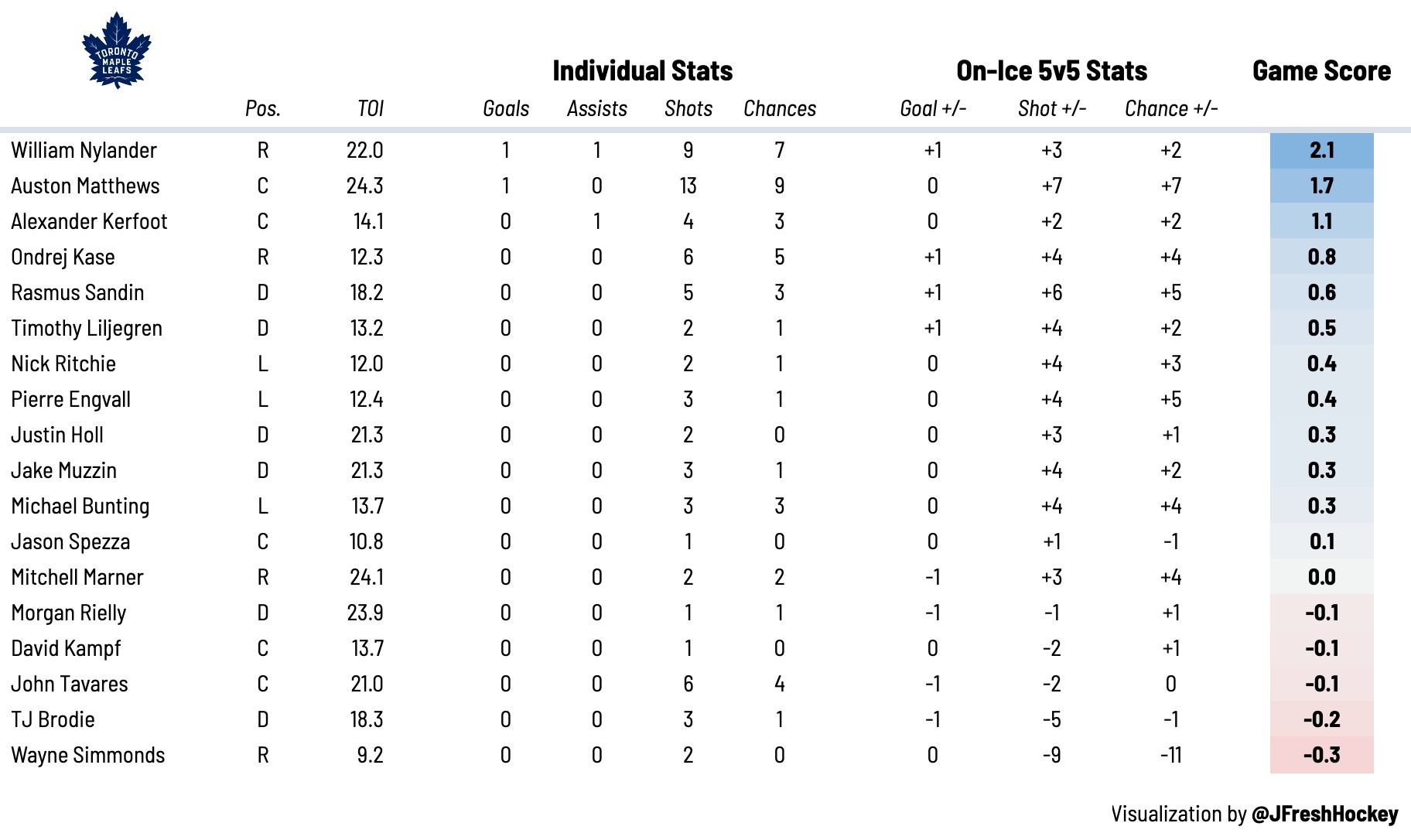
Tweets of the Night
There really isn't any aspect of this that's that concerning.
The Leafs are 1st in 5v5 xGF/60 on evolvinghockey.
They're 1st in 5v5 xGF on moneypuck.
They're 1st in 5v5 xGF/60 on naturalstattrick.This is a shooting% problem. The bottom 6 is contributing.
— Jules (@clairevoix498) November 12, 2021
As much as I get frustrated with the checking line, it’s worth noting they’re due for some more goals. As bad as Kampf is offensively, the Leafs aren’t going to keep shooting three percent with him on the ice at even strength. Engvall, too. We’ll see some more goals from that line, even if it’s less than I’ll want to see.
When the Lsafs win, but its all the core 4. pic.twitter.com/vu4mEx8foE
— MrShinySides (@sides_shiny) November 13, 2021
Must suck to have your best players producing while your team leads the NHL in all major categories offensively.
























